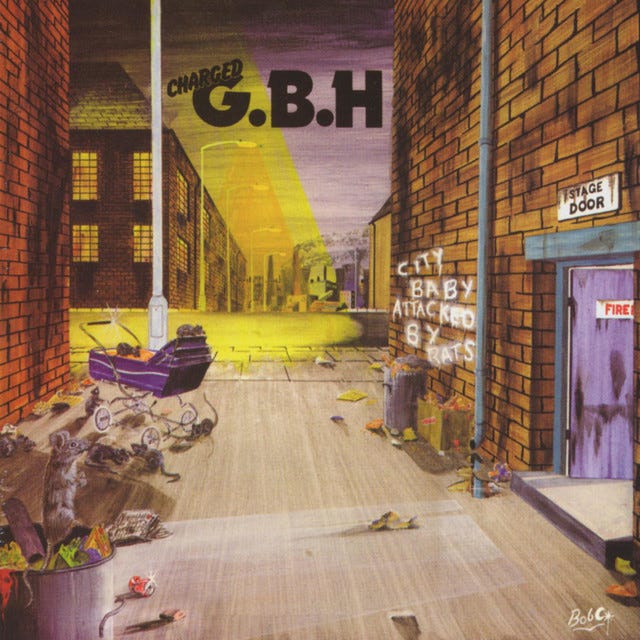EVERY GENRE PROJECT - September 12 - Street Punk
Genre of the Day - Street Punk
Album of the Day - City Baby Attacked by Rats by Charged G.B.H. (1982)
The sights of the streets are rife with endless curiosities. Just yesterday, walking home from a friend’s house, my friend and I spotted what looked like a cat from afar. Upon closer inspection, it looked to be moving rather marsupially and we realized it was one of the mysterious street sights of all: an opossum. The dangers, electricity, and the surprises of the streets are a creative realm we haven’t encountered much in music thus far. Today’s genre spins tales that embody the grittiness of the streets lining decaying urban centers, sketching the scene with metallic and percussive aggression.
Punk is a thoroughly urban phenomenon, arising in the midst of English urban decay and partly as a reaction to gray brutalism. Street punk arose in the context of punk’s growing convergence with post-modern, artsier strains of thought. Those strains had been in punk’s DNA since its protozoan days. Many punk musicians bristled against them as the movement continued to grow and increasingly debate and adjust to notions of authenticity, preferring its rawer, DIY origins. It certainly isn’t the only genre to value street-cred so heavily, but street punk epitomized its use as a litmus test.
Street punk placed emphasis on punk’s capacity to transmit the sounds of day-to-day, on-the-streets issues of blue collar workers into confrontation and catharsis. Though “Ghost Town” was not in the same sonic venue as street punk, the 1981 UK-number one single painted a similarly gloomy picture of industrialization’s decay and lost promises and the “government leaving the youth on the shelf.” street punk evolved out of the onomatopoeic (a word that still bedevils me whenever I try to spell it) Oi! movement, which had arisen in the late ‘70s with spirited sing-along choruses and working-class themes. Street punk retained its group vocals, unfiltered working-class expressions, and catchiness while hardening its sound even further, adopting increasingly brash metal overtones. As a hair dye enthusiast, I appreciate that street punk paved the way for all future hair-abusers by embracing unnatural, exaggerated hair colors.
G.B.H.—shorthand for Grievous Bodily Harm—formed in Birmingham, a city seemingly still so miserable for youth that the first YouTube video that pops up merely upon searching the city’s name is startlingly titled “THE UK’S WORST CITY.” The silver lining of that status is the creative gold G.B.H. was able to mine from its streets in the boldly titled effort City Baby Attacked by Rats. In terms of guitar tone, the key sonic variation within punk and hardocre besides percussion, their rendition of street punk strikes a nice middle ground between Discharge’s stormy sound (which is also classified by some as street punk) and later, higher-octane visions of hardocre like Japanese hardcore. The urgency of the opener “Time Bomb” is blistering; Colin Abrahall’s snarling yet grounded voice stands out in a sphere where the voice is often abstracted to the point of incomprehensibility. “Wardogs” is a surprisingly effective criticism of neocolonial interventionism, its frantic drums and upwards-skating riffs hitting like artillery. Its roadside ruminations are consistently razor-sharp, the knife occasionally turned inwards (“Self Destruct”). It reminds us of the importance of setting in music, and that the streets act as a musical studio of their own in producing unrepentant visions of harsh realities.





